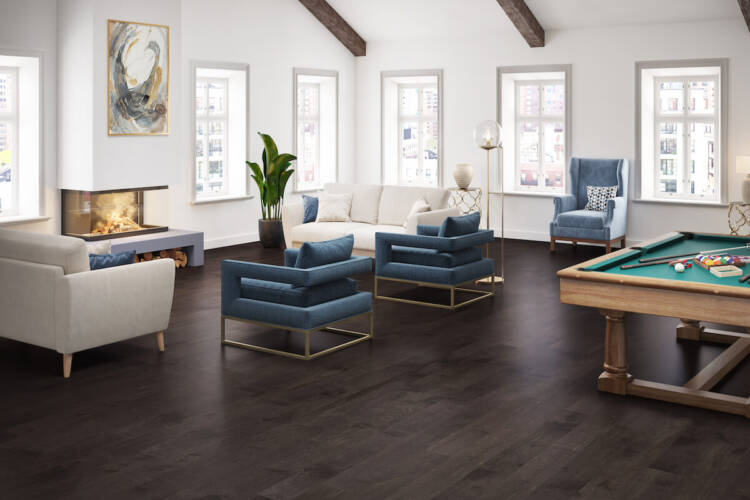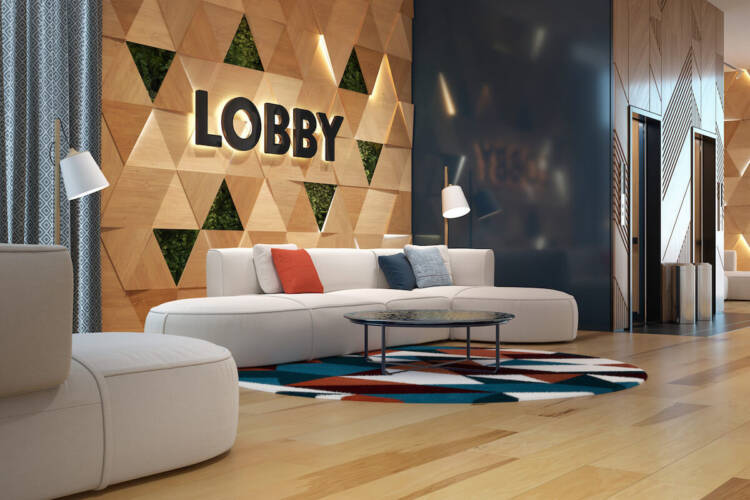Why LVT is the Best Flooring for Your Rental/Investment Property
The process of selecting the best flooring for your rental property comes down to two very important things: what are your long-term plans for the property; and what type of tenants do you have in mind?
The reason these questions are important to ask is because oftentimes the future plans of your rental property will impact your approach to its interior design. And because flooring is one of the key components of any interior design process, it’s best to solidify get a handle on your future plans and prospective tenants before selecting the best flooring for your rental home.
Click here to download this year’s LVT look book.
What is the Purpose of Your Rental Property?
Determining the purpose of your property is an important first step to selecting the eventual flooring product — as well as other design attributes. The reason this is important is that the answer will ultimately help you justify what type of flooring to invest in.
For instance, if you’re a property manager looking to redesign a handful of rental apartments for the long term, then you’re going to want to install flooring that’s durable.
However, if you’re a property owner looking to renovate or build a multi-unit apartment building and flip it in the short term, chances are you’re looking for a stylish flooring solution that appeals to potential buyers.
In both cases, LVT and engineered hardwood are ideal flooring solutions — not only in terms of the desired durability and design versatility, but also in terms affordability and value.

What Type of Tenants Do You Have in Mind?
The challenge of finding the best flooring for your rental property is that you have minimal regulation over your tenant’s actions. Not only do you have little control over if and how often they choose to clean, but you also can’t control how they treat your property (e.g. do they drag the couch across the floor?). The control barrier is easily one of the biggest headaches of owning a rental property — which, as a result, can make it a challenge to select the right flooring.
So ideally, who do you have in mind as a tenant? Is your property near a college, and therefore, are your prospective tenants students in their early 20s? Are you in an urban environment and your future tenants are young professionals who want an upscale-looking, yet affordable place to live? Or are your tenants going to be 55+ and looking for a quiet and comfortable living space?
Rental Property Tip: While LVT and engineered hardwood are extremely durable products, the truth is that every hard surface will endure heavy foot traffic and use. And because you will never have complete control over the actions of your tenants, it’s a good idea to always include safeguards in your contracts or lease agreements. Leave your tenants instructions and tips on how to keep the floors clean, which will show them you are serious about maintaining the interior of your investment property.
LVT and hardwood are both optimal solutions for the above-mentioned tenant types. LVT can withstand the wear and tear from the college crowd, while simultaneously offering an incredible amount of design versatility and affordability. LVT and hardwood are perfect choices for both younger professionals and older tenants, with hardwood adding just that extra touch of luxury and sophistication.
Also, both options are extremely durable; items dropping to the floor like a ceramic bowl or a blow dryer will likely cause very little damage to LVT or hardwood as opposed to harder elements like ceramic, porcelain or marble.
Because of its non-porous nature and ease of maintenance, LVT is also an ideal flooring solution for families with children and/or pets.
How LVT Can Enhance the Interior of Your Rental Property

When showing a rental property to prospective tenants, it’s important to sell them on the interior design. The flooring you select understandably plays a major role in this effort and is often a make-it or break-it factor. For example, how off-putting would it be to show an apartment with old, stained carpet for flooring? Conversely, how appealing would it be to show an apartment with beautiful hardwood or wood-look flooring?
Both LVT and engineered hardwood flooring allow you to lend your rental property any look you desire. LVT can replicate the look of almost any natural material, including stone, ceramic, marble and concrete. Hardwood can elevate any space and add a bit of luxury and style to any multi-family home. Plus, the tones and colors in Parterre’s engineered hardwood and LVT collections complement each other, so you can use both in different areas of the same rental property.
Whether it’s the look of hardwood, stone, ceramic, concrete or marble, LVT replicates almost any natural material, lets you go beyond the natural design and offers patterns and colors that natural elements don’t — such as contemporary geometric patterns.
After you determine your desired tenants and which flooring solution might be best, the next thing you’ll naturally want to do is conduct a cost comparison of other flooring products to ensure it meets your budget.
How the Cost of Your Flooring Factors In
Cost is another important factor to consider when looking for the best flooring for your rental property. Certain products can be cost-prohibitive and simply may not make sense for your property in the long-term.
Replacement costs should also be considered when comparing the cost of LVT versus other flooring material. For instance, it’s far easier (and less expensive) to replace a piece of LVT than it is to replace an entire section of carpet. Whether it’s due to damage or because styles change over time, you’ll inevitably need to replace your flooring at some point.
Refer to the following chart for a better idea of the cost comparison between LVT and other flooring materials:
- LVT— LVT can cost anywhere from $2–$5.50 per square foot for commercial-grade material, not including installation. Vinyl offers reduced maintenance costs, which allows for greater value over time.
- Linoleum —Linoleum is comparable to LVT, oftentimes falling within the same pricing range. When factoring in the additional maintenance needed for linoleum, LVT is a dependable and affordable flooring solution.
- Concrete — Depending on the look and complexity, concrete can cost between $2–$6 per square foot and up to $15–$30 per square foot for more elaborate finishes. This pricing is also dependent on whether a concrete slab currently exists and the amount of preparation that is needed to apply stain or polish to the concrete.
- Carpet — Carpet costs on average $3–$4 per square foot, but has been known to increase to $4.50-5.50 per square foot when installation is factored in. Cost of upkeep and replacement will dramatically increase the lifetime cost of carpet.
- Laminate —At $.50–$5 per square foot, laminate is comparable to luxury vinyl flooring. However, it lacks flexibility in terms of design and application.
- Hardwood — The average hardwood floor costs between $4–$20 per square foot, but the higher price tag reflects the level of luxury, quality and sophistication that comes with natural flooring products.
Best Places to Install LVT in Your Rental Property
Luxury vinyl flooring can work well in pretty much any room within your rental property — bedrooms, living rooms, dining rooms, etc. And because it’s non-porous, vinyl is highly resistant to moisture — making it ideal for kitchens and bathrooms. LVT also makes for a seamless transition between rooms and oftentimes helps make a space seem larger than if you were using two different flooring products.
Additionally, rental properties with common space like lobbies, hallways, recreation rooms and gyms are also ideal for LVT. And if your rental property has multiple floors, don’t forget about the elevator flooring as well.
Why LVT and Hardwood are the Best Flooring Options for Your Rental Property
There are many reasons LVT and hardwood are the best option for your rental property. Here are a few of them:
- LVT works well in any room or space within a rental property, including common areas, hallways, entrances and elevators.
- LVT is water-resistant and can handle spills or moisture.
- Both LVT and hardwood are highly resilient in terms of damage caused by tenants and easy to maintain.
- LVT is flexible to install — can be applied over most surfaces. When it comes to hardwood, you can choose from floating, glue down or staple methods for installation.
At Parterre, we’re committed to providing LVT and engineered hardwood in a variety of design options — no matter the space. Contact us today to learn more about our rental property flooring solutions.
Sandra Drake
Vice President of Sales
With over 20 years of commercial LVT experience, Sandra has worked in Business Development for the Healthcare, Government and Education Segments of a large flooring manufacturer. Moving into a role as Senior Director of commercial LVT product development and sourcing, working directly for the SVP of Commercial Hardsurface. Sandra also has worked with companies to develop new LVT product lines and unique patterns with designers.
Sandra is certified with Speak Easy and Dale Carnegie and a member of IIDA, ASHE/AHA, RFCI, and NEWH.
Polished Concrete vs. Vinyl Flooring
Polished Concrete vs. Vinyl Flooring Polished concrete vs. vinyl flooring. It’s not an easy decision, considering both provide an excellent solution for commercial flooring. The look of concrete floors has been a growing trend for commercial interiors.
Chevron and Herringbone
Break the Pattern of Commercial Flooring You can add more flair to your commercial flooring by breaking from the look of traditional straight-line, square, and diagonal patterns. Eye-catching looks like chevron and herringbone will dot the designer landscape in 2024.